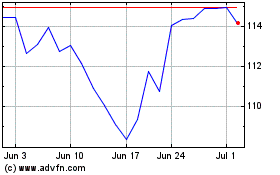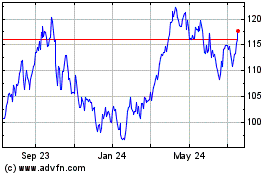By Nick Timiraos
The Federal Reserve said it would start making loans to American
corporations, relaunching a crisis-era tool to help calm short-term
debt markets that have faced intensifying strains in recent
days.
The Fed trained its sights Tuesday on dysfunction in the $1.1
trillion market for short-term corporate IOUs called commercial
paper. Companies use commercial paper to finance their day-to-day
business operations such as payroll expenses.
While the Fed can't buy corporate debt or lend directly to
households and businesses, it can invoke emergency powers to
establish lending facilities that, in turn, extend credit.
The steps show how the Fed is repurposing its tools from the
2008 crisis to combat an unfolding economic emergency that is
entirely different. Back then, fears about the solvency of key
financial institutions spawned a crisis that fueled a broader
economic contraction.
Now the problems are in the economy, which needs the financial
system and government to tide over businesses and households forced
to hunker down to prevent the coronavirus pandemic from overloading
local health-care systems.
"What economic policy can do here is to create a safety net for
the economy, and particularly for individuals and firms that don't
have buffers, that aren't able to absorb lost wages or lost
revenues," said Nathan Sheets, a former senior official at the
Treasury Department and the Fed who is now chief economist at
investment-advisory firm PGIM Fixed Income.
Complicating that task is uncertainty everywhere: about the
length and severity of the economic downturn; about the regulatory
system's ability to handle an abrupt deleveraging; and about how
financial firms will function with remote operations and
alternative work arrangements.
"The problem with trying to create a distinction between
economic and financial crises is that it ignores the fact that the
real economy and the financial sector are inextricably linked, and
thus there is no way to have a crisis in one without it immediately
causing a crisis in the other," said Joshua Shapiro of consulting
firm MFR Inc.
In launching the Commercial Paper Funding Facility, the Fed is
trying to encourage investors to return to that market to ensure
that eligible issuers can roll over maturing obligations. The
central bank's facility will purchase three-month debt from firms
with high credit ratings. The Fed deployed a version of the tool
between 2008 and 2010, during and after the financial crisis.
"The Fed is trying to break the fear loop that corporates will
lose access to the short-term markets by committing that funding
will exist," said Alexandra Wilson-Elizondo, senior credit
portfolio manager at MacKay Shields. "It's a symbol. A healthy
commercial-paper market gives companies confidence in the term
market."
Investors who buy longer-dated debt gauge the pulse of
short-term funding markets to assess risk. Analysts and asset
managers were alarmed to see disruptions in commercial paper, in
which yields were higher than those for certain long-dated bonds.
That either meant companies were desperate for cash or that buyers
had disappeared. If short-term debt instruments are in trouble,
that could signal tough times ahead.
As an example of restored faith and a well-functioning
high-grade credit market, Exxon Mobil Corp. issued debt across
various maturities Tuesday, borrowing at a rate of around 4% on a
30-year bond.
Tuesday's announcement marked the Fed's first effort in the
current crisis that required consultation with the Treasury
Department, potentially opening the door to other joint ventures
between fiscal and monetary authorities.
To create the latest facility, the Fed had to invoke special
powers by citing "unusual and exigent circumstances" to authorize
one of its reserve banks, the New York Fed, to extend credit. In
2010, Congress required the Fed to seek approval from the Treasury
secretary before using these so-called 13(3) powers, named for the
section of its charter that allows it to set up such last-resort
programs.
Treasury Secretary Steven Mnuchin gave his approval to the
program Tuesday. The Treasury will also provide $10 billion from
its Exchange Stabilization Fund, which has around $94 billion, to
cover any Fed credit losses.
Later on Tuesday, the Fed announced another 13(3) lending
program that will enable 24 large financial institutions known as
primary dealers, which function as the Fed's exclusive
counterparties when trading in financial markets, to seek loans of
up to 90 days.
The Primary Dealer Credit Facility will essentially function as
an overnight loan facility for primary dealers, similar to how the
Fed's discount window provides a round-the-clock source of backup
funding to banks. It represents the Fed's latest bid to unclog
financial markets.
The facility will offer terms as generous as those made
available in the fall of 2008. Primary dealers will be able to
pledge a broader range of collateral than the government-backed
debt required for open-market operations, and the Fed will charge
the same 0.25% rate being made available for banks at the discount
window.
The commercial-paper market has been strained as money-market
mutual funds and other investors seek to sell commercial paper at
the same time that demand for short-term borrowing is rising from
companies that face unanticipated, virus-related funding needs.
The Fed said it would lend to commercial-paper issuers at a rate
of 2 percentage points above overnight lending rates for three
months at a time. The facility will last for at least one year.
"The terms are not easy," said Julia Coronado, a former Fed
economist and founder of the economic-advisory firm MacroPolicy
Perspectives. "It was a mild disappointment to the market."
The facility differs from the 2008 version in one important way.
While both are only open to firms with strong credit ratings, the
new facility will also allow firms that currently have strong
credit ratings but whose ratings are later downgraded by one tier
to access the facility.
In 2008, the facility took three weeks to launch, and this
change could give companies greater confidence that they will able
to access credit even if their ratings are downgraded before the
facility is fully operating.
Tuesday's announcement is one example of how policy makers in
the days and weeks ahead may need to repurpose old tools and invent
new ones to address a working-capital crunch for small and midsize
businesses and the self-employed.
Michael Feroli, chief U.S. economist at JPMorgan Chase, said one
possible scheme would allow the Fed to provide nonrecourse funding
for loans underwritten by banks to small- and midsize companies at
the Fed's primary credit rate, 0.25%.
Such loans could be limited to firms that were in good credit
standing as of the start of the year, to avoid lending to
enterprises that were distressed before the virus hit. Relying on
the banking system could reduce the administrative burden on the
central bank or the Treasury associated with underwriting tens of
thousands of borrowers.
The Fed has moved over the past two weeks to address growing
market strains at a pace that has surprised veterans of the 2008
crisis, which unfolded over many months.
On March 3, the central bank approved an emergency cut in its
benchmark federal-funds rate by a half-percentage point. On Sunday,
it slashed the rate by a full percentage point, to near zero.
The Fed also announced plans to purchase $500 billion in
Treasury securities and $200 billion in mortgage bonds to arrest
funding strains in critical markets for government debt, which are
typically havens during a crisis. And it has promised to offer
unlimited amounts of short-term loans to large banks that are
collateralized by government securities.
--Julia-Ambra Verlaine contributed to this article.
Write to Nick Timiraos at nick.timiraos@wsj.com
(END) Dow Jones Newswires
March 17, 2020 22:09 ET (02:09 GMT)
Copyright (c) 2020 Dow Jones & Company, Inc.
Exxon Mobil (NYSE:XOM)
Historical Stock Chart
From Mar 2024 to Apr 2024

Exxon Mobil (NYSE:XOM)
Historical Stock Chart
From Apr 2023 to Apr 2024
